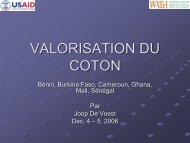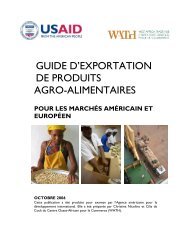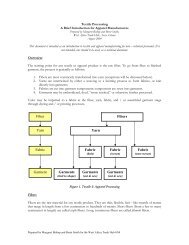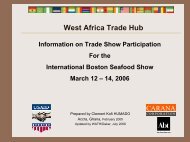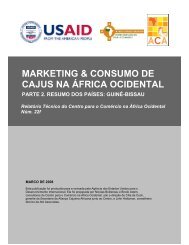Shea Butter A Guide to Production and Marketing - AGOA Export ...
Shea Butter A Guide to Production and Marketing - AGOA Export ...
Shea Butter A Guide to Production and Marketing - AGOA Export ...
You also want an ePaper? Increase the reach of your titles
YUMPU automatically turns print PDFs into web optimized ePapers that Google loves.
Peace Corps Ghana Version 1, March 2008<br />
Roots<br />
The roots are used as chewing sticks in Nigeria, most commonly in savannah areas<br />
(Isawumi, 1978). Roots <strong>and</strong> root bark are ground <strong>to</strong> a paste <strong>and</strong> taken orally <strong>to</strong> cure<br />
jaundice (Ampofo, 1983). These are also used for treatment of diarrhoea <strong>and</strong><br />
s<strong>to</strong>machache (Millee, 1984). Mixed with <strong>to</strong>bacco, the roots are used as a poison by<br />
the Jukun of northern Nigeria. Chronic sores in horses are treated with boiled <strong>and</strong><br />
pounded root bark (Dalziel, 1937).<br />
Bark<br />
Infusions of the bark have shown <strong>to</strong> have selective anti-microbial properties, as being<br />
effective against Sarcina lutha <strong>and</strong> Staphylococcus mureas but not mycobacterium<br />
phlei (Malcolm & Sofowora, 1969). Macerated with the bark of Ceiba pent<strong>and</strong>ra, <strong>and</strong><br />
salt, bark infusions have been used <strong>to</strong> treat cattle with worms in the Tenda region of<br />
Senegal <strong>and</strong> Guinea (Ferry et al., 1974). The infusions have been used <strong>to</strong> treat leprosy<br />
in Guinea Bissau (Dalziel, 1937) <strong>and</strong> for gastric problems (Booth <strong>and</strong> Wickens, 1988)<br />
as well as for diarrhoea or dysentery (Soladoye et al., 1989). A bark decoction is used<br />
in the Cote d’Ivoire in baths <strong>and</strong> therapeutic sitz-baths <strong>to</strong> facilitate delivery of women<br />
in labour, <strong>and</strong> is drunk <strong>to</strong> encourage lactation after delivery (Abbiw, 1990; Soladoye<br />
et al., 1989; Louppe, 1994). However, in northern Nigeria such a concoction is said <strong>to</strong><br />
be lethal, (Dalziel, 1937).<br />
A bark infusion is used as an eyewash <strong>to</strong> neutralise the venom of the spitting cobra<br />
(Soladoye et al 1989) <strong>and</strong> also, in Ghana, as a footbath <strong>to</strong> help extract jiggers.<br />
Greenwood (1929) noted that the stripping of bark for medicinal purposes may have a<br />
severe impact on the health of shea trees <strong>and</strong> may even be fatal. The wood is only<br />
used when individual trees are not valued for butter production. The latex is heated<br />
<strong>and</strong> mixed with palm oil <strong>to</strong> make glue (Hall et al., 1996). It is chewed as a gum <strong>and</strong><br />
made in<strong>to</strong> balls for children <strong>to</strong> play with (Louppe, 1994). In Burkina Faso, Bobo<br />
musicians use it <strong>to</strong> repair cracked drums <strong>and</strong> punctured drumheads (Millee, 1984). It<br />
contains only 15-25% of carotene <strong>and</strong>, therefore, is not suitable for the manufacture of<br />
rubber (André, 1947a,b).<br />
Industrial Uses<br />
Research in<strong>to</strong> the properties <strong>and</strong> potential industrial uses of shea butter began in the<br />
first few decades of the last century. Previously, it was used in edible fats <strong>and</strong><br />
margarine, <strong>and</strong> was only beginning <strong>to</strong> attract the soap <strong>and</strong> perfume industry when<br />
interest ceased because of the 2nd World War. Revival of the shea industry after the<br />
war suffered serious setbacks from an insufficient pricing mechanism, logistical<br />
problems of transport (low availability <strong>and</strong> unpredictable) unable <strong>to</strong> cope with the<br />
supply of the nuts, thus making the ventures economically non-viable. During the mid<br />
1960s shea trade re-emerged when Japanese traders joined their European<br />
counterparts, which saw a considerable expansion of the industry, particularly in the<br />
cosmetics <strong>and</strong> confectionery industry barely a decade thereafter.<br />
<strong>Shea</strong> butter has several industrial applications, but the majority of kernels<br />
(approximately 95%) provide an important raw material for Cocoa <strong>Butter</strong> Replacers<br />
(CBRs), <strong>and</strong> are used for manufacturing chocolate <strong>and</strong> other confectionery. Minor<br />
Page 9 of 28



